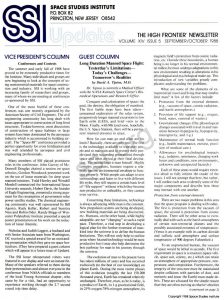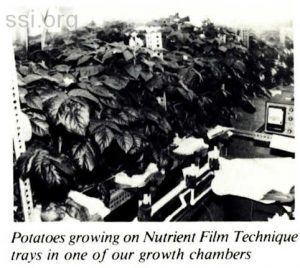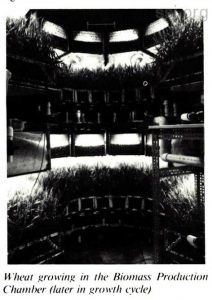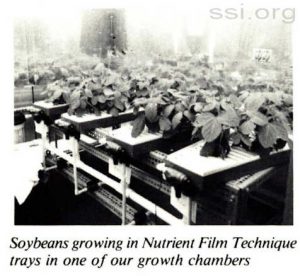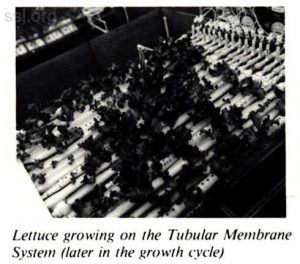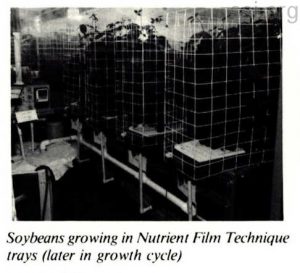SPACE STUDIES INSTITUTE
P.O. BOX 82
PRINCETON, NEW JERSEY 08542
[[librarian note: This address is here, as it was in the original printed newsletter, for historical reasons. It is no longer the physical address of SSI. For contributions, please see this page]]
SSI UPDATE
THE HIGH FRONTIER NEWSLETTER
VOLUME XIV ISSUE 5
SEPTEMBER/OCTOBER 1988
VICE PRESIDENT’S COLUMN
Conferences and Contests
The summer and early fall of 1988 have proved to be extremely productive times for the Institute. Many individuals and groups are now beginning to look at the concepts of using nonterrestrial materials for space construction and industry. SSI is working with an increasing family of researchers and groups, many of whom we are meeting at conferences co-sponsored by SSI.
One of the most fruitful of these conferences was one recently organized by the American Society of Civil Engineers. The civil engineering community has long dealt with issues appropriate to construction of long-lived structures. To date however, most discussions of construction of space habitats or large systems have been dominated by the aerospace industry which is accustomed to building aircraft. The “Space 88” conference provided a perfect opportunity for cross fertilization and was well attended by aerospace and civil engineering professionals.
Many members of SSI played prominent roles in the conference. John Garvey of McDonnell Douglas chaired a session on space robotics, Gordon Woodcock presented work on the use of lunar materials for deep space manned missions. Todd Hawley and Wendell Mendell summarized the International Space University research, Hubert Davis, the founder of Eagle Engineering, presented a strong argument for the resumption of government solar power satellite studies. The chemical engineering community was well represented by Bill Agosto, Rudy Keller, Robert and Sumitra Ness and Robin Oder. Randy Briggs of Worcester Polytechnic Institute presented a special poster presentation on his work on the reduction of lunar ilmenite.
Nicholas and Judith Leggett, a husband and wife Senior Associate team from Washington, DC received a special award for an outstanding presentation which they gave on space horticulture. (They have prepared a guest column which will appear in a future issue of Update).
The SSI lunar teleoperated robots were featured in our display and were an instant hit. Many of the speakers referred to them during their presentations and almost everyone in the conference from NASA officials to members of the local Young Astronaut chapter, who came by for a visit, had an opportunity to experience working through the 2.7 second round trip time delay.
SSI’s lunar mining experiments were also of considerable interest to this community and we made a number of good contacts as a result of our discussions there. Special thanks to all the SSI members who attended and helped with the conference.
The Institute will also be involved with several important conferences in 1989. First and foremost is our own Space Manufacturing Conference at Princeton University. This year’s event will feature John Aaron, Assistant Administrator for Exploration and Head of NASA’s new Office of Exploration as the keynote speaker. Congressman Robert Torricelli will welcome conference participants. Representative Torricelli (NJ) has been an outspoken proponent of a vigorous and intelligent US Space Program and we are delighted at his acceptance of our offer to attend the conference.
Lunar Polar Probe
In conjunction with our May 1989 Conference, the Institute will host a special invitation only two-day workshop on Lunar Polar Probes immediately prior to the Conference. The results of the workshop will be summarized in a Thursday evening conference session on May 11, 1989 which will be open to all conference participants. The workshop will be chaired by Dr. Gay Canough, a physicist from Notre Dame University and Fermilab. We will have further announcements on this workshop and related meetings in future newsletters.
SSI is also sponsoring two additional conferences during the first half of 1989. We will be in attendance at the Space Development Conference in Chicago over Memorial Day weekend. In addition we are a co-sponsor of the International Astronautical Federation Conference on Space Power which will be held June 6-9, 1989 in Cleveland, Ohio. This Conference will be hosted by the NASA Lewis Research Center and chaired by Dr. Peter Glaser.
Space Colony Design Contest
The Institute is also participating in a space colony design contest conducted by the National Space Society. Three prizes of $2001.00 will be awarded for the best habitat designs submitted as both small scale models and plans. It is planned that the top design will also be executed as a professional quality display model. The entries will be exhibited at the Space Development Conference in Chicago, next May. For a kit of rules and a registration packet contact NSS. We encourage all members of SSI to participate in this exciting competition.
Gregg Maryniak
GUEST COLUMN
Long Duration Manned Space Flight: Yesterday’s Limitations, Today’s Challenges, Tomorrow’s Realities
by David A. Tipton, M.D.
Dr. Tipton is currently a Medical Officer with the NASA Kennedy Space Center’s Biomedical Operations and Research Office.
Conquest and colonization of space: the goal, the destiny, the obligation of mankind. The first feeble steps have been taken unmanned exploration of the solar system, progressively longer manned excursions to low Earth orbit (LEO), and brief visits to the Moon. Finally, with Mir (and soon, hopefully, the U.S. Space Station), there will be a permanent manned presence in space.
How far can man go and what are his limits? Basically, there are only two. The first is the technology available to transport people and to maintain and to protect these people (and their succeeding generations) through space and upon arrival at their final destination. The second limit is man himself. Highly complex organisms, humans require a relatively narrow environmental envelope to function properly. While people can adapt to new surroundings and learn to live with different life styles, they still require a certain basic level of “life support” without which they become non-productive or unhealthy, or they cannot even survive.
Concerning these limitations, technology is always advancing while man is the constant. New propulsion systems are being developed, new building materials are being discovered, etc. Humans, on the other hand, while highly adaptable, are not “changing” at such a rapid pace. Therefore, a vital step in developing a logical plan for the further extension of mankind into the universe is to define the human limitations. This will not only help to outline areas where focused technology would be most productive but it may also help determine the best pathway for man in his journey through the universe.
The evolution of man to his present form has taken millions of years and has occurred exclusively (to the best of our knowledge) on planet Earth. During the most recent phases of this evolution (roughly the last 150-200 thousand years), Earth has remained relatively unchanged. Therefore, man, as he is today, is a product of Earth, its 1-g gravitational field, its 21% oxygen-78% nitrogen atmosphere, its magnetic field’s protection from cosmic radiation, etc. Outside these boundaries, a human being is no longer in his normal environmental milieu; he must undergo adaptations to this new environment resulting in alterations in his physiological and psychological make-up. This introduction of new variables greatly complicates understanding the problems.
What are some of the elements of extraterrestrial travel and living that may tend to limit man? A few of the factors include:
1. Protection from the external elements (e.g., vacuum of space, cosmic radiation, and harsh atmospheres.)
2. Provision of life support (e.g., oxygen, food, water, removal of wastes.)
3. Gravitational changes (The physiological changes associated with travel in and transition between hypergravity, hypogravity, microgravity, and 1-g.)
4. Maintenance of normal body function (e.g., health maintenance, exercise, provision of medical care.)
5. Allowances for psychological impacts (e.g., isolation, remoteness, changing work hours and conditions, new environments, unknown and unexpected hazards.)
Each of these areas would require extensive detail to fully inform the reader of the issues. I will not attempt that here, but rather, I will outline each area to identify some of the major components and describe how these may interact with one another.
Protection from external elements
There are two major problems in this area that the space program is dealing with today. The first is protection from the vacuum of space, the second is protection from cosmic radiation. There will be other areas to eventually deal with such as the harsh atmospheres of certain non-terrestrial planets and the possibly associated extremes of temperature. (Venus is an example with its carbon dioxide and sulfuric acid atmosphere and surface temperature of 900 degrees Fahrenheit.)
To an unprotected human, the vacuum of space would be lethal in seconds. The first requirement in space is a structure (space vehicle, space suit, colony, etc.) which can retain an atmosphere of appropriate pressure, temperature, and composition. Furthermore, the integrity of the structure must be maintained despite collisions with particles of dust, and meteoric and (near the Earth) man-made debris. These are a hazard for the simple reason that they are often moving at relative velocities of 10-20 km/sec or more. A minute particle at this speed has the energy of a rifle bullet. Computer simulations have been developed which provide some information on the likelihood of an impact in various orbits; they are helpful in designing shielding and predicting orbital lifetimes. Of course they are useless as predictors of when any given space structure will actually be struck.
Editor’s Note: (An article on Space Debris will appear in an upcoming issue of Update.)
Another major aspect of dealing with the vacuum of space is EVA (extravehicular activity). Now we not only have to protect a person in a self contained ensemble, but we have to assure the person sufficient mobility to accomplish the mission. Furthermore, this mission may be in microgravity (LEO, transit between planets, etc.), hypogravity (e.g., the Moon), or someday possibly even hypergravity. The major trade-offs to date have been between suit mobility, which decreases as suit pressures increase, and dysbarism, which increases in incidence as suit pressures decrease. Dysbarism (e.g., the bends) is caused by dissolved gasses in the blood (principally nitrogen) which form bubbles when an individual is too rapidly introduced to a low pressure environment. The bubbles then travel through the blood vessels until they can go no further because of their size. At this point, blood supply to surrounding tissue is cut off producing symptoms primarily involving the joints, the lungs, the nervous system, and the cardiovascular system.
The incidence of dysbarism can be reduced by prebreathing oxygen, thereby ‘washing out’ nitrogen via the lungs, or by increasing suit pressures which reduces the relative decrease in atmospheric pressure that the individual is exposed to. The chief problem with prebreathing is the long time required – hours. It not only severely limits the productivity of the crew during the prebreath period, but it may also be impractical during an emergency situation where minutes may make a life-or-death difference. As indicated above, the alternative of increasing suit pressure greatly diminishes the mobility of the crew member. This not only makes his task considerably more difficult, but forces him to expend much more energy, literally fighting against the suit to move. This, today, is one of the most important areas being addressed.
For Space Station, a decision has been made to have an ‘Earth-normal’ environment. Among other things, this will allow life sciences research to eliminate the variable of atmospheric differences when performing experiments on physiologic changes in microgravity.
However, for future missions such as space colonies, missions to other planets, space factories, etc., another option is available which must be considered. Pressures and gas compositions other than ‘Earth-normal’ are being examined. There are, of course, both pros and cons to any of the potential systems. On the positive side, a reduced atmospheric pressure will reduce the probability of bends occurring during EVA, as well as reduce the relatively high suit pressure necessary, thus simplifying this complex engineering task. Furthermore, reduced atmospheric pressure will reduce the pressure on spacecraft walls, thereby lightening structural requirements and adding a safety margin. Additionally, these reduced pressures will result in reduced weights of supply and resupply gasses. On the negative side, reduced atmospheric pressure requires an increase in the oxygen fraction (in order to prevent hypoxia – reduced oxygen to the body). This increase in the percentage of oxygen, !n turn, may increase in the risk of fire hazard. This, in fact, was a contributing factor to the Apollo 1 launch pad fire; as a direct result of this tragedy. high oxygen atmospheres were essentially eliminated from normal space craft launch operations.
While these are a few of the more obvious factors associated with the potential option of reduced atmospheres for long duration manned missions, many more issues will have to be examined before a final decision to use this pathway can be made. This examination should include, among other things, an extensive evaluation of the expected human physiological changes that would be associated with the non ‘Earth-normal’ environment. Additionally, all other systems on board the space craft would need to be evaluated. Would the additional off-gassing from potentially volatile space craft systems be a significant added hazard? Would the required augmentation of air movement and heat exchange devices nullify the structural engineering gains? Would the operational parameters of the equipment be unchanged? And what of the other biological systems (e.g., plant and animals) onboard the craft: Would their physiology, growth characteristics, and health be altered (if maintained at cabin pressure)? Would the CELSS (Controlled Ecological Life Support System) crops have diminished yields? Would the quality of the products be the same? These, and many other questions, would have to be answered before the decision to permanently colonize a reduced atmosphere facility is made.
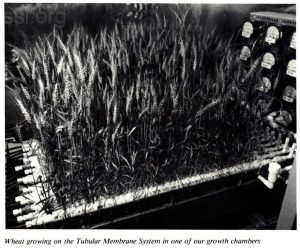
Radiation can be divided into two major types, ionizing and non-ionizing. The effects of non-ionizing radiation is a topic receiving much attention lately. It seems that “the main biological effect of non-ionizing radiation is the production of heat within tissue. However, for ultraviolet radiation (in addition to thermal reactions) other biological effects can occur… such as skin erythema, eye inflammation… and skin cancer. Similarly, visible radiation can also produce nonthermal transient effects to the eye (iritis, eye fatigue, etc.).” [NASASTD-3000, section 5.7 Radiation]
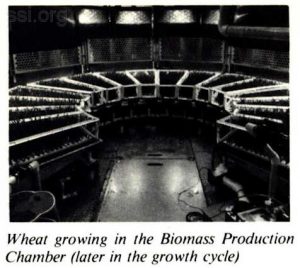
The major radiation concern for long duration space missions and space colonization centers on the biological effects of ionizing radiation. The chief sources of ionizing radiation for current space travelers are geomagnetically trapped radiation belts (the Van Allen belts), galactic cosmic radiation, solar high energy radiation, and man-made nuclear radiation. I shall exclude this last item from further discussion as it should be controllable with proper manufacturing and adequate safety procedures. Humans are protected from most of the elements of ionizing radiation by the Earth’s magnetic field. These elements consist of particles (electrons, protons, neutrons, alpha particles and heavier nuclei particles) as well as electromagnetic radiation (x-rays and gamma rays). But once we’ve travelled beyond LEO, we are no longer protected. These particles and electromagnetic radiation sources affect people by damaging individual cells. This is done as the ionizing radiation passes through the body, transferring its energy to the tissue. This ability to transfer energy to the tissue is measured in a unit called the rad (radiation absorbed dose). However, different elements, independent of the amount of energy transferred, have different abilities to affect biological tissue. Thus a quality factor for different types of radiation is introduced in order to calculate the dose equivalent, which is the biologically damaging ionizing radiation. The dose equivalent is measured in a unit called the rem (Roentgen equivalent man). The relationship between these units is:
dose equivalent (rem) = dose (rad) times the quality factor
The quality factor ranges from one for x-rays, gamma rays, and electrons; about 2-10 for neutrons and protons; and 15-20+ for alpha particles and heavier nuclei particles.
The acute effects of radiation are based on short term exposure to relatively high doses. Usually little effect is seen up to 50 rads, even higher in some people. Above that one begins to see symptoms in the gastrointestinal system (such as nausea, vomiting, diarrhea, and hemorrhage), the blood forming elements (decreased white blood cells and platelets), the skin (redness and skin blistering), the reproductive system (sterility in males), the vascular system (shock), and the neurological system (swelling of the brain and other nervous tissue). The extent of the damage and its relative reversibility is dose dependent. Of course, with high enough doses, death can result.
The latent, long-term effects of ionizing radiation are based on more subtle damage, probably at the nuclear level. The principal concerns are cancer (mainly leukemias, though other cancers can occur) and genetic effects. These effects have been used to determine the current NASA career limits which are set at 200 + 7.5 (age 30) rem for males and 200 + 7.5 (age 38) rem for females, with a maximum of 400 rem regardless of age. This is based upon a maximum 3% lifetime risk of radiation induced mortality. One could note from the equations above that a male aged 3 or under or a female aged 11 or under would not be acceptable for “career” space travel. This, of course, is not compatible with the goal of space colonization which would eventually involve pregnant women, birth in space, and the raising of children.
The protection of space travelers will involve two separate components. The first is the long term protection of humans from the background radiation produced by the elements outlined above. The second is the short term protection needed during high energy solar flares. The only practical protection currently available is mass shielding. Though there are other experimental techniques under consideration such as electromagnetic shielding and pharmacological agents. Neither of these, however, is currently practicable.
Protection against ionizing radiation can be provided by surrounding oneself with mass. Any sort of mass will do, though some are more efficient than others. Calculations of the amount of shielding required for long-term protection range from 5-7 meters of lunar soil to 9 cm of aluminum. Protection must be provided in all directions; even solar particles can come from virtually any direction due to deflection of the charged particles by planetary and solar magnetic fields.
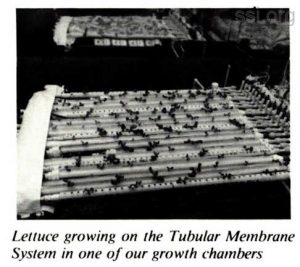
Such a massive layer of shielding would be relatively simple to arrange on the lunar or martian surface, but would be a major problem for a space colony. To fully shield even a small spacecraft and then accelerate it to interplanetary speeds for flight to Mars would be impossible with current technology.
To provide protection to a colony outside of LEO, various imaginative approaches have been proposed, including a plan to boost lunar soil to the colony. For interplanetary craft, a small, heavily shielded “storm cellar” to which the crew could retreat during solar flares has been proposed. A crew could possible accomplish a single flight to Mars with such a storm cellar for solar flares and minimal shielding at other times. It is difficult, however, to see how one could spend an entire life (or even a few years) in interplanetary space without totally new concepts in radiation shielding or in propulsion (to allow thousands of tons of shielding to be carried). Another option, of course, might be the acceptance of a higher risk.
The development of new methods for provision of life support is one of the most exciting areas in today’s space program. Additionally, it is a critical area in our quest for colonization of the solar system (and beyond). Our current method of supplying food, water, and oxygen is to take up what we need. Waste management consists primarily of neutralizing any potentially toxic wastes and storing the rest until return to Earth. This has proven acceptable, in fact often preferable, for short term flights; but for long term flights and space colonization, a regenerative life support system of some kind will be absolutely mandatory. The logistical nightmare of supplying (from Earth sources) large numbers of people at great distances would so quickly overwhelm the system as to make it unrealistic.
The two principal types of regenerative life support systems are physicochemical and biological. To a small extent the U.S. Space Program uses physicochemical systems to control waste products, but virtually no attempt has been made to regenerate useful products with either method. Currently, work is ongoing at NASA to develop a CELSS (Controlled Ecological Life Support System). The system under study utilizes primarily biological regenerative processes, though, to a lesser extent, physicochemical processes are used as well.
The CELSS program consists of three major interrelated components: biomass production, biomass processing, and waste processing. While the prime thrust of the program today deals with higher plant production and processing, other biological systems are currently undergoing preliminary evaluation, e.g., fish, algae, and bacteria. Eventually, other animals will be introduced into the experimental system. Also, work that is being done is examining the problems associated with development of a CELSS in microgravity versus development of CELSS in a +g non-terrestrial setting (whether that be the Moon, Mars, a rotating space colony, or wherever). These latter questions are currently only being addressed in the planning stages.
The biomass production group is looking at how different types of plants can be grown under the controlled circumstances one could expect off the Earth. Some, but by no means all, of the important issues being dealt with include how to maximize edible biomass in minimal volume with minimum use of energy and manpower. The biomass processing group is addressing the processing of mature crops, and the production of meals from these crops. The prime issues here are the provision of palatable and varied diets that are nutritionally sound, given the restrictive production conditions. To complete the cycle, the waste processing group is examining how the inedible biomass, the other by-products of the crops, and the wastes from the crew can be processed to provide material which can be usefully reintroduced into the system. Again, the major issues are to provide acceptable and sufficient products with a minimum of energy, volume and manpower.
One issue that all the groups are addressing in concert is that of crop selection; eventually this will also include selection of animal species. Since a lot of effort is needed to establish a new crop with a CELSS, the selection of that crop becomes critically important. We want to make sure that at least a number of important preliminary questions have been answered before the crop is introduced. Therefore, the biomass production people need to determine the difficulties associated with raising the crop, special requirements of the crop, its relative percentage of edible biomass, and how it fits in with other crops. The biomass processing people need to determine the specific difficulties in processing the raw crop material, and production of foodstuffs. They also need to establish how the crop meets the nutritional and dietary requirements of the crew. Finally, the waste processing group to determine any special requirements or difficulties in dealing with the inedible biomass and other waste products of the crop. These are but a few of the factors that will need to go into the critical decisions that are to be made.
Obviously, a lot of hard work and many tough questions remain. However, this is truly exciting and essential research that must precede any definitive steps towards humans becoming self-sufficient spacefarers.
Gravity Effects
It appears from the abundance of data collected in manned space flight and in man and animals in simulated microgravity states (e.g., bed rest, immobilization, head down tilt, etc.), that virtually every system in the body is affected. And yet we have only dealt with the tip of the iceberg in defining the changes, let alone beginning to fully understand the physiology of these changes or to develop countermeasures to them. I will not even attempt to outline all the physiological changes that occur (that we know of), but will refer the reader to the literature, including three excellent reference texts:
1. Biomedical Results of Apollo, NASA SP-368
2. Biomedical Results from Skylab, NASA SP-377
3. Space Physiology and Medicine, NASA SP-447
In brief summary, the cardiovascular system is affected by a headward shift of fluids, a loss of body mass (primarily fluids), a reduction of venous tone, and a deconditioning of the cardiovascular system, including the heart, the latter probably a result of decreased hydrostatic loading. The musculoskeletal system is also unloaded, resulting in a loss of muscle mass and bone mineral. The neurological system is affected, especially the vestibular system, often resulting in some degree of motion sickness. The effects on the endocrine system include, but are not limited to, changes in the hormones that affect electrolyte balance, calcium balance and regulation of metabolism and growth. The hematopoietic system is depressed resulting in reduced total mass of red blood cells. The effects on the immune system include suppression of some of the body’s normal responses to pathogenic microorganisms.
The rate of adaption to the new environment varies from system to system. Fluid shifts equilibrate in hours; the vestibular system adapts in days. The cardiovascular system reaches a new equilibrium point in weeks; the skeletal system has not yet demonstrated (in U.S. manned space flight experiments) a new set point. The time scale of muscle changes has been obscured by varying types and amounts of exercise performed by different crewmembers.
The relative importance of each of these issue. has not been fully determined – and the determinations that have been made are often very situation specific. For instance, the problems associated with cardiovascular and musculoskeletal changes are not so much related to remaining in microgravity, but rather become more of a concern when the crew member enters a +g state (e.g., arrival at the Moon or Mars, or return to Earth). At this point, the deconditioned systems may be unable to cope with the acute stresses placed upon them. Also, the changes in calcium balance and associated demineralization of bone – will they be associated with stone formation and calcium deposits in the kidneys, gall bladder, or soft tissue; will they result in insignificant reversible conditions upon return to Earth, or will pathological bone fractures occur? As another example, though significant changes have been seen in laboratory test of the immune system, clinically there has been no increase in the number of infectious diseases, either inflight or post-flight. Is this just coincidence, or are there other aspects of the immune system which compensate for the identified changes? Is it feasible to subject man to very long duration microgravity states, or will some level of artificial gravity be necessary? Upon return from long duration microgravity or hypogravity exposure, will immediate return to Earth be feasible, or will some type of “rehabilitation” be necessary? If so, perhaps an orbiting variable gravity facility could be used where spacefarers are exposed to activities at every increasing g loads before returning to Earth. And, finally, how will the effects on these various systems relate to issues of space colonization such as conception, gestation, birth, and growth in reduced gravity settings?
These are but a few of the questions that remain to be answered. And there is only one way we will ever be able to answer these questions. It is absolutely essential for the future of manned space flight, for the future of space colonization, that a systematic program be developed to understand the basic physiological changes associated with space flight. This program must include studies of the long duration effects of space flight as well as the readaptation that occurs upon return to Earth. Furthermore, for this study to answer many of the questions that will arise for space colonization, it ultimately must be expanded to include data points between the microgravity of a space station and the 1 g of Earth. Some of these studies could be conducted on the Moon (in the relatively near future if we set our mind to it), on Mars, and on a variable gravity facility. Only when these concerns have been reasonably addressed can we begin to truly answer the myriads of life sciences questions associated with the development of space colonies.
Health maintenance
Space medicine is unlike most of today’s other medical fields in that the prime mission involves keeping healthy people healthy in a potentially hostile environment rather than dealing with ill people in an attempt to arrest or reverse their disease. This, of course, is only the first step in the eventual evolution of space medicine. Other aspects of the specialty which will develop (or in some cases have already occurred to a limited degree) include dealing with illnesses that develop because of the nonterrestrial environment the person is exposed to; the development of a disease (not related to the space travel itself) which had been previously undetected in the flight crew member; and the treatment of disease which is more easily controlled in a space environment. Though all these new situations can and, undoubtedly, will develop, it will still be paramount to the space medicine specialist to keep his subject as healthy and as fit as possible.
A complicating issue here is that when man is exposed to a gravity level other than one g, his body undergoes physiological adaptation to this new state (as discussed in more detail above). When the gravity is less that 1 g, the effects of this readaptation are essentially equivalent to deconditioning of the cardiovascular and musculoskeletal systems. This deconditioning is probably not a problem as long as one need only deal with routine microgravity (or hypogravity) operations. However, under emergency conditions where a high level of activity would be necessary, especially in a higher g setting (e.g., an emergency egress from a return to Earth vehicle), the individual mav be physically incapable of meeting the physiological challenge. For this reason, an exercise regimen, possibly coupled with other measures such as electromyostimulation or pharmacological agents, could become essential parts of long duration manned space flight. Many questions have been raised as to the types of exercise, length and frequency of exercise, and how the exercise protocols should be coupled with other regimens. While much research is ongoing to address these questions, the definitive answers will not come until we have had an opportunity to experiment on board Space Station; and even then we may still need additional data points that will only be available with partial gravity research, such as on the Moon or in a variable gravity facility.
Another aspect of health maintenance currently being addressed in the U.S. Space Program is the optimal way to deal with illnesses that arise during space flight, especially aboard Space Station. While this is a program specific initiative, it still deals with the same fundamental principles that space travelers will have to deal with for the next several years. These issues include:
1. What is the likelihood of occurrence and survivability of any particular disease in the population?
2. What equipment and supplies are necessary to prevent, diagnose, and/or treat these diseases?
3. What level of skill in medical care personnel is appropriate to prevent, diagnose and/or treat the likely diseases?
4. What are the allowable weight, volume and power requirement limits for equipment and supplies.
5. What is the allowable manpower allocation for the space vehicle – does it allow for the “appropriate” level of dedicated medical care personnel?
6. What type of medical evacuation capabilities are available to the crew?
The answers to these questions will vary with each mission. The initial manning of the U.S. Space Station will consist primarily of “highly fit,” medically screened individuals; a future space colony may consist of “average” people. The Space Station may be equipped with a vehicle that can deorbit to a definitive medical care facility within hours; a manned Mars mission will have virtually no opportunity to return an ill or injured crew member until the mission is complete. It is clear that the design of a space medical care facility will greatly depend on a number of different issues. A few of them have been identified and outlined here, but by no means all. The important points now are not necessarily related to designing the facility, but rather to defining the questions that must be answered.
Psychological impacts
There is a lot of speculation about what the psychological impact upon crew members will be when faced with long duration space missions. Obviously, much will depend upon the type of mission, the type of craft, crew makeup, etc. The U.S. Space Program has little personal experience to draw from. The longest mission to date has been the 84 day Skylab 4 mission. There have never been any significant psychological events in flight during the U.S. Manned Space Program related to long duration space flight, fear of isolation, etc. (It is necessary to point out here that I am referring to the psychological effects that one may see in long periods of isolation, not acute reactions that would be appropriately expected to occur when emergency situations arise such as the rupture of the pressure tank on Apollo 13.) However, by examining other analogous situations such as the Soviet space program, wintering over at the Antarctic, and long-duration submarine duty, it is clear that this potential problem must be recognized, and an initial plan must be developed to deal with it.
Initial studies have indicated that important criteria that must be considered for predicting appropriate psychological adjustment to long duration space flight include:
a. Length and type of mission
b. Working conditions
c. Crew size
d. Crew composition (age, sex, scientific background, education, etc.)
e. Selection criteria and preselection screening
f. Ability of crew to function together as a unit
g. Living conditions – amount of privacy, ability to communicate with family, aesthetics of surroundings, etc.
h. Ability to egress in the event of a mishap – concept of security/risk
These are but a few of the initial considerations currently identified for Space Station (and to some extent for interplanetary flights such as to Mars). As our knowledge grows with greater experience, we will better define the factors associated with a healthy psychological status of crew members. Another point to recognize is that virtually all the planning being done is aimed at current concepts of missions to space, not at the concept of space colonization – where the outpost, be it a space colony or another planet, is home. This will require a totally new perspective of the situation.
Summary
In this paper, I have attempted to identify some of the potentially limiting factors in long duration manned space flight. In no way can this be construed as an all inclusive list of the problems that we face; nor should one infer that summaries of the basic problems are comprehensive in scope. Rather, by familiarizing the reader with these issues, it is hoped that he or she will have a better understanding of the challenges of the manned space program and a better appreciation for the work facing such a momentous human undertaking. Furthermore, it is important for the reader to understand how vital it is for the U.S. to return to space, and how important it is to design, build, launch, and permanently occupy the U.S. Space Station. This capability and resource represent the first opportunity to conduct the work that must be completed before mankind can truly colonize space.
9th SSI/PRINCETON CONFERENCE ON SPACE MANUFACTURING
MAY 10-13, 1989
The 9th Biennial SSI/Princeton Conference on Space Manufacturing, sponsored by Space Studies Institute, is a forum for papers on all aspects of the use of non-terrestrial resources. The program includes papers both on technical aspects of space development and on the social sciences.
In order to accommodate a broad range of presentations, three different types of presentations will be encouraged: 1) the traditional presentation of papers in the auditorium at the Woodrow Wilson School, 2) a poster session and display, 3) an evening roundtable for interaction between participants.
The first three days of the Conference will be open only to registered participants. A summary session on Saturday, May 13 is free and open to all.
SUBMISSION OF ABSTRACTS
Abstracts of papers received by January 15, 1989 will be considered for inclusion in this Conference. Please limit abstracts to one page with no references.
Abstracts and other inquiries should be sent to:
Ms. Barbara Faughnan,
Conference Coordinator
Space Studies Institute
P.O. Box 82,
Princeton, NJ 08542
PEER REVIEW
Voluntary peer review is available. Papers submitted for peer review must be received in entirety by January 15, 1989.
Authors will receive reviewers’ comments for their own information only. Papers will not be accepted or rejected on the basis of peer review.
CONFERENCE PROGRAM
Following is a listing of sessions and session chairmen scheduled for this year’s Space Manufacturing Conference:
– Keynote Address
John Aaron,
NASA Office of Exploration
– Welcoming Address
Hon. Robert C. Torricelli,
Democratic Representative from New Jersey
– Welcoming Remarks
Gerald K. O’Neill,
President,
Space Studies Institute
– Biomedical Considerations
James Logan,
NASA Headquarters
– Space Manufacturing and Space Power
Peter Glaser,
Arthur D. Little Company
– Artificial Biospheres
Mark Nelson,
Institute of Ecotechnics
– External Tanks and Space Habitats
Tom Mobley and Faye Bailiff,
Martin Marietta
– Nonterrestrial Resources
John Lewis,
Lunar and Planetary Laboratory
– Space Transportation
Ed Bock,
General Dynamics
– International and Economic Considerations
Irwin Pikus,
Department of Commerce
– Poster Session
James Burke,
Jet Propulsion laboratories
BANQUET, Friday, May 12
Banquet Speaker:
Robert J. Cenker,
Payload Specialist, G.E. Astro
Ramada Inn Princeton, New Jersey
REGISTRATION
A registration fee of $290 includes lunches, coffee breaks and the Friday night banquet. Registration through the Space Studies Institute is available.
©space studies institute
NEXT: 1988 November-December (Congress and President back SSI)

